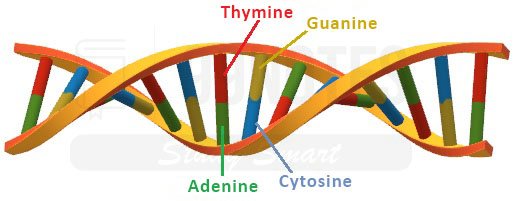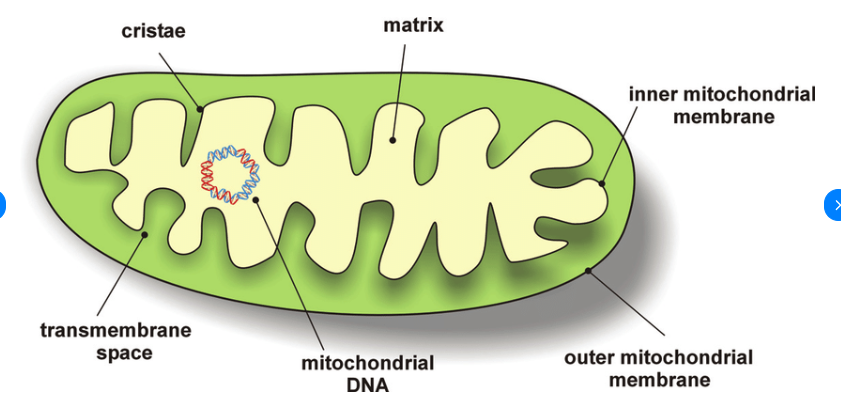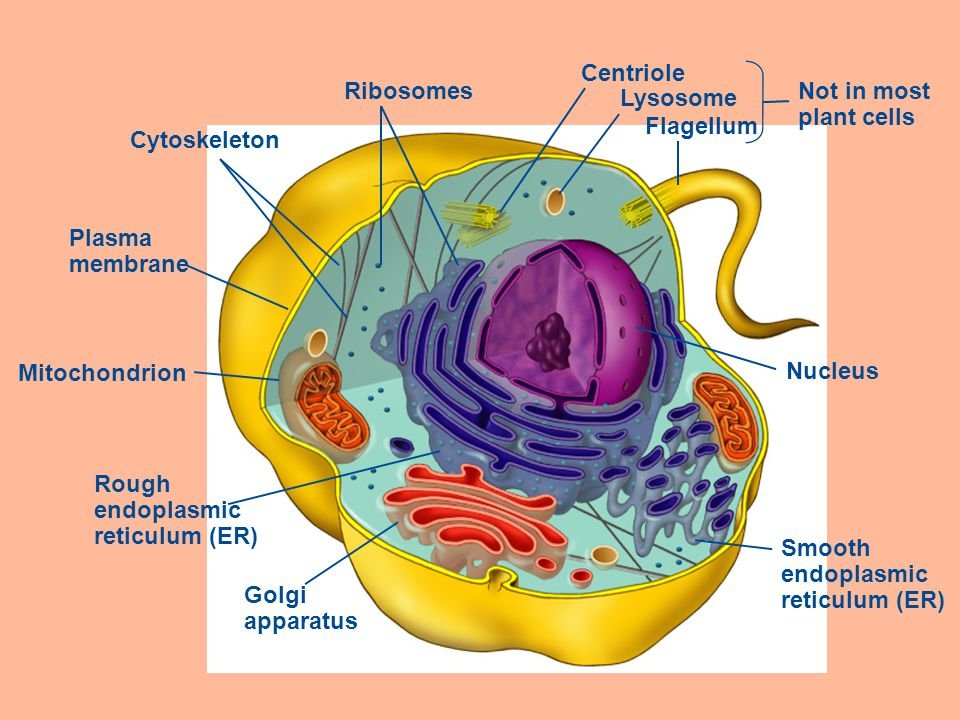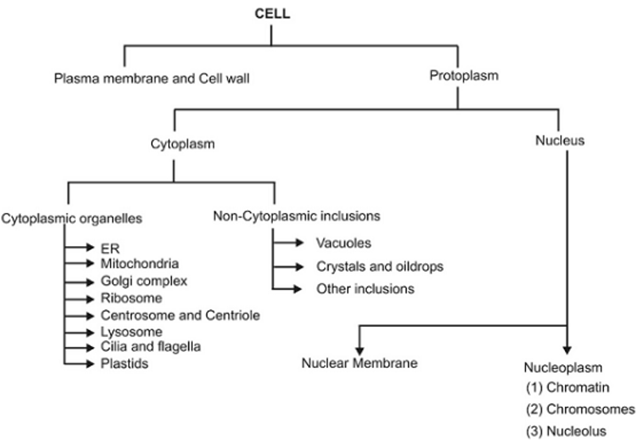Cells
In Biology, a Cell is a basic membrane-bound unit that contains the fundamental molecules of life. It is the fundamental unit of life, i.e. all life form is composed of cells.
What is Life?
The Question of what is life is not centred around what living things have, it is what they do. We find that all living things perform certain basic functions.
Characteristics of life
All living things are considered to follow the following checklist: Movement, Respiration, Sensitivity, Growth, Reproduction, Excretion, and Nutrition.
We can remember this checklist with the help of the mnemonic phrase: MRS. GREN.
But this checklist is about the life that we see today; In the beginning, life was much simpler. Life began the moment that molecules of information started to reproduce and evolve by natural selection.
But this life was very simple and might not have involved a few of the above characteristics. Therefore, life has been defined according to the following four rules by many biologists.
4 rules of Life:
- Self-Assembly: It must work to avoid decay and disorder OR work to restore its order.
- Emergence of Cell Membrane: Thus, it must have a closed system.
- Self-Replication & Autocatalysis (Itself acting as a catalyst): They must have some molecule that can carry information(order).
- Evolution: This information must evolve by natural selection.
All these functions are performed in the cells. These cells are made of proteins (Chains of folded amino acids) which are synthesised by the DNA in the cells. Therefore, proteins can be considered as the building blocks of these cells.
|
How did life first form? |
| Stanley Miller’s first primordial soup Hypothesis: He mixed Ammonia, Methane & Hydrogen (roughly the initial concentration of the atmosphere) and passed electricity through it. After a few days, he found Amino acids. The building blocks of protein & life. |
Discovery of Cells:
The Cell was discovered by Robert Hooke in 1665 with the help of a primitive microscope. He studied (dead) cork cells- like empty boxes. Soon Leeuwenhoek (1674), with an improved microscope, discovered the free-living cells in pond water for the first time.
For the next 150 years, not much was known. But in the 19th century due to improvement in the microscopes, several new developments took place.
- Robert Brown (1831): Discovered the nucleus in the cell.
- Purkinje (1839): coined the term ‘Protoplasm’ for the fluid substance in the cell.
- Schleiden (1838) & Schwann (1839): Cell Theory: All plants and animals are composed of cells and the cell is the basic unit of life.
- Virchow (1855): Expanded Cell theory: All cells arise from pre-existing cells.
- 1940: Discovery of electron Microscope: Complex structure of Cell thrown open.
How to see the cell in Microscope: Colour it first with Iodine solution, Safranin solution or Methylene solution. To prevent the cell from getting dry, some starch solution is added to it.
Structural Organisation of Cell
All cells are composed of 3 basic features:
- Plasma Membrane,
- Nucleus and
- Cytoplasm.
Plasma Membrane
The Plasma Membrane (or the Cell Membrane) separates the content of the cell from the external environment.
Function of the Plasma Membrane:
- It restricts plasma flow through the Plasma membrane and also cytoplasmic membrane.
- It allows the restricted entry and exit of some materials while preventing the movement of others. We call it a selectively permeable membrane.
- The flexibility of the cell Membrane enables it to engulf food and other materials from the external environment. [Process: Endocytosis, For example, In Amoeba]
- Some substances can move freely in & out. For example, CO2, O2, Water; by process of Diffusion. If the concentration is low inside, material flows in, and vice versa. Selective allowance of water molecules = Osmosis = Passage of water from high concentration to low concentration.
- If an Animal/ Plant cell is put into a sugar/salt solution If the concentration of the solution is high, water will flow into the solution; and vice versa. Unicellular freshwater organisms and most plant cells tend to gain water through osmosis.
- Two types of Transport in Cells:
- By Diffusion: Requires no energy & happens automatically.
- One that requires energy in the form of ATP.
Cell Wall (Only Plants):
Rigid outer covering, mainly composed of Cellulose (complex substance, that provides structural strengths to plants). It lies outside the plasma Membrane. Cell wall is found in Plants, Fungi, Bacteria, algae & archaea.
- Plasmolysis: When living plant cells lose water through Osmosis (in a hypertonic solution- high concentration) there is shrinkage or contraction of the contents of the cell away from the wall. Well wall stands like a firm structure and don’t let the cell collapse.
- But Plasmolysis do not occur in dead cells.
- Cytolysis: Reverse of above. In a Hypotonic solution (low Conc.). In such cases, the Cell wall prevents the cell from bursting from internal pressure. This happens in plants, fungi and bacteria.
Cytoplasm
The large region with fluid content inside the cell membrane. (It takes very little stain – transparent in the compound microscope). It contains many specialised cell organelles. Each is enclosed by a membrane. Each cytoplasm has specific functions.
- Prokaryotes don’t have membrane-bound organelles; Eukaryotes do.
- Viruses lack any (outer) membranes & hence do not show characteristics of life until they enter a living body & use its cell machinery to multiply.
Cytoplasm contains three types of substances:
- Cytosol: A water-based solution that contains ions, small molecules, and macromolecules.
- Organelles: Membrane-bound structures that are suspended in the cytosol.
- Cytoskeleton: A network of fibres that supports the cell and gives it shape
Organelles are subcellular structures that perform specific jobs within a cell, similar to how organs function in the body. Nucleus is the most important organelle. Other organelles include Endoplasmic reticulum (ER), Golgi Apparatus, Lysosomes, Mitochondria, and Plastids.
Nucleus: 
Under the slide of a cell, different areas appear to have different darkness. There is a dark structure near the centre of the Cell is a Nucleus.
Functions of a Nucleus:
- Contains Genetic Information and plays a central role in cellular reproduction (the process by which cell divides)
- Controls growth: It plays a crucial part, along with the environment, in determining the way the cell will develop and what form it will exhibit at maturity, by directing the chemical activities of the cell.
It has a double-layered membrane, which allows the transfer of material from inside the nucleus to its outside (cytoplasm) through pores.
| Nucleoid: When the nuclear membrane is absent (like in Bacteria); The area containing Nucleic acid is Nucleoid. |
Chromosomes and Chromatin
-
- Chromosomes are Composed of DNA and Proteins.
- DNA (Deoxyribonucleic Acid) molecule: Contains the information necessary for the inheritance of traits from parents to the next generation, as well as the instructions for constructing and organizing cells.
- Functional segments of DNA are known as Genes.
- Chromatin: Complex macromolecule found in the nucleus of Eukaryotic cells. It consists of DNA protein and RNA (Ribonucleic Acid).
- Chromatin vs Chromosomes: In a non-dividing cell, DNA is present as part of the chromatin material, which appears as an entangled mass of thread-like structures and is invisible under a light microscope. Whenever a Cell is about to divide, chromatin material gets organized into chromosomes.
Understanding RNA & DNA
Both Ribo-Nucleic Acid (RNA) and Deoxyribo-Nucleic Acid (DNA) are genetic information to synthesise protein. Both are composed of nucleotides that serve as the basic building blocks of DNA and RNA. 
A nucleotide is an organic molecule, made up of a five-carbon sugar, a nitrogenous base, and one or more phosphate groups. The Nitrogenous base can be of several types, including, Adenine (A), Cytosine (C), Guanine (G), Thymine (T), Uracil (U) etc. The nucleotides are named after these bases.
RNA Contains ATCU nucleotides and has a single helix structure.
Whereas, DNA contains ATCG nucleotides in different orders and has a double Helix structure. However, these can occur only in a particular order in each strand of the helix. A can pair only with T and G can pair only with C in any order.
Central Dogma of Molecular Biology:
To make protein modern cells follow 3 steps:
- Replication: It is a process by which DNA is replicated. The double helix is first unzipped using an enzyme called Helicase. Then, another enzyme DNA Polymerase acts on each of the single strands and creates new DNA. Lastly, the enzyme named DNA ligase seals up the fragments of DNA in both strands and folds up the helix structure. The two DNA molecules now contain one old and one new DNA strand each.
| A Gene: It is the functional segment of DNA. Each gene segment has a starting point called the promoter end portion is known as the terminator. |
- Transcription: copy genes from DNA to RNA; The RNA Polymerase Enzyme temporarily unwind and opens and then uses new nucleotide bases in the nucleus to form an RNA strand. This strand is known as the Messenger RNA (m-RNA). Some unnecessary portions of RNA are also removed from this strand.
- Translation: use this RNA as a blueprint to make proteins. The processed Messanger RNA moves in the cytoplasm. Here Ribosomes bind to the messenger RNA to form a chain of Amino acids. This is how a protein is formed.
Thus, all the basic functions of life are driven by the processes run in the nuclei of the cells.
Cells can be classified based on the nuclear membrane:
| Prokaryotic | Eukaryotic |
| Prokaryotic (primary nucleus): Lack Nuclear membrane; | Eukaryotic (New Nucleus): Have Cell membrane; |
| Lack of cytoplasmic membrane-bound organelles. Many of the functions of such organelles are performed by poorly organized parts of cytoplasm. | Have Cytoplasmic Membrane-bound organelles. |
| Generally small: 1 Micron | Generally large: 5-100 microns |
| Single chromosome | More than one chromosome |
| The Chlorophyll in photosynthetic prokaryotic bacteria is associated with membranous vesicles (bag-like structure). | Chlorophyll in Plastids (Chloroplast) |
Cytoplasm
The large region with fluid content inside the cell membrane. (It takes very little stain – transparent in the compound microscope). It contains many specialised cell organelles. Each is enclosed by a membrane. Each cytoplasm has specific functions.
- Prokaryotes don’t have membrane-bound organelles; Eukaryotes do.
- Viruses lack any (outer) membranes & hence do not show characteristics of life until they enter a living body & use its cell machinery to multiply.
Cytoplasm contains three types of substances:
- Cytosol: A water-based solution that contains ions, small molecules, and macromolecules.
- Organelles: Membrane-bound structures that are suspended in the cytosol.
- Cytoskeleton: A network of fibres that supports the cell and gives it shape
Cell Organelles
(Eukaryotic cells only):
Organelles help the cell to carry out various chemical reactions to support the complicated structure & function of the cell. Some important cell organelles are:
Endoplasmic Reticulum (ER)
[Reticulum: a network of net-like structures]: A large network of membrane-bound tubes and sheets, appearing as long tubules or round/oblong vesicles. Its structure is similar to the plasma membrane. 
Two types:
- Rough ER: Looks rough under the microscope because it has particles called ribosomes attached to it.
- Ribosomes: Site of protein manufacture, attached to active cells. Proteins are sent to various places using ER.
- They receive m-RNA from the Nucleus to manufacture these proteins.
- Smooth ER: Helps in the manufacture of fat molecules, or lipids (fat-related molecules), important for cell function.
- Some of these proteins and lipids help in building cell membranes (Process: Membrane biogenesis).
- Some others function as enzymes and hormones.
The function of ER:
- Serve as channels for transport of materials (esp. proteins) between various regions of cytoplasm or between cytoplasm & nucleus.
- Serves as a cytoplasmic framework providing a surface for some biochemical activities of the cell.
- In liver cells(in vertebrates), SER plays a crucial role in detoxifying many poisons & drugs.
Golgi Apparatus:
Golgi Apparatus is a set of Membrane-bound vesicles arranged approximately parallel to each other in stacks (called cisterns). The membrane often has a connection with ER & therefore constitutes another portion of a complex cellular membrane system.
(Described by Camillo Golgi, found a way to stain individual nerve and cell structure: ‘black reaction’; Won the Noble Prize in 1906 for work on the structure of the nervous system)
Functions of Golgi apparatus:
- Material synthesised near the ER is packaged and dispatched to various targets inside and outside the cell through the Golgi Apparatus.
- It Stores modifies & packages products in vesicles.
- In some cases: complex sugars may be made from simple sugars in the Golgi apparatus.
- It is involved in the formation of Lysosomes.
Lysosomes:
Lysosomes are membrane-bound sacs filled with digestive enzymes, which are manufactured in the Rough ER (RER). It performs two functions:
- Keeps cell clean by disposing of any foreign material (bacteria, food) and worn-out cell organelles. Breaks into small pieces with the help of powerful digestive enzymes. = Waste disposal system of cell.
- During disturbance in cell metabolism(For example, the cell gets damaged), it bursts & enzymes digest its own cell. = Suicide bags of cells.
Mitochondria 
Mitochondria (plural of mitochondrion), are the Powerhouse of the cell. The energy required for various chemical activities is released in the form of ATP (Adenosine triphosphate = energy currency of the cell). Used for making chemical compounds and for mechanical work.
- It has 2 membrane coverings: The outer membrane is very porous while the inner is deeply folded. These folds create a large surface area for ATP-generating chemical reactions.
- It too contains DNA.
Plastids
Plastids are found only in Plants. These synthesise important chemical compounds stored and used by cells. Plastids can be of two types:
- Chromo-plasts (coloured plastids): For example, Chloroplast contains a green pigment called chlorophyll and other yellow/orange pigments.
- Leucoplasts (white or colourless plastids): Primary organelles in which materials like starch, oil & protein granules are stored.
The internal organization of the Plastids consists of numerous membrane layers embedded in a material called Stroma. They are similar to mitochondria in external structure and like mitochondria have their own DNA & ribosomes.
Vacuole:
Storage sacs for solid or liquid contents. Small in animals and very large in plants (sometimes 50-90% of volume).
- In Plants: Vacuoles are full of cell sap and provide turgidity & rigidity to the cell. Many substances important for the life of plants are stored in vacuoles, including amino acids, sugars, various organic acids, and some proteins.
- In Amoeba, the food vacuole contains the food items that the amoeba has consumed.









